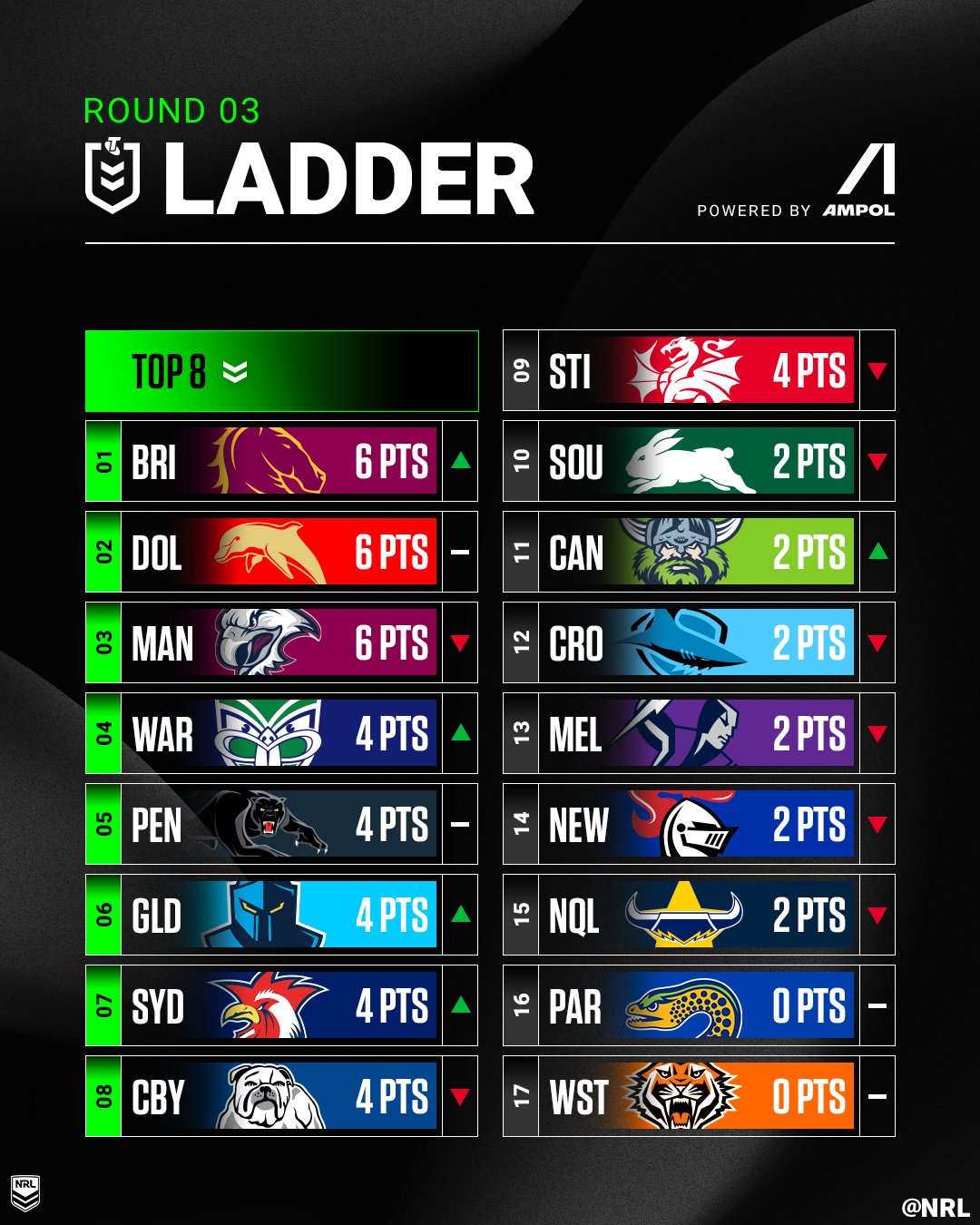The NRL (National Rugby League) ladder is a crucial aspect of the sport, serving as a standings table that determines the ranking of teams based on their performance during the season. It provides an overview of team statistics, match results, and points accumulated, allowing fans and analysts to evaluate team standings and predict outcomes. This guide will delve into the NRL ladder, its significance, and how it influences the season’s outcome.

What is the NRL Ladder?
The NRL ladder is a league table that ranks teams in the National Rugby League based on their performance throughout the regular season. It provides a snapshot of each team’s wins, losses, draws, points scored, and points conceded. The table not only helps fans understand the overall standings but also serves as a tool for determining playoff qualifications, home-field advantages, and positioning for finals.
Structure of the NRL Ladder
The NRL ladder consists of several metrics that determine team rankings:
- Win-Loss Record:
- Teams are ranked based on their win-loss record. A win earns a team two points, a draw earns one point, and a loss earns zero points.
- Points Differential:
- Points differential (the difference between points scored and points conceded) often serves as a tiebreaker. A higher points differential often indicates a stronger team performance.
- For and Against:
- Points for and against refer to the total number of points a team scores and concedes during the season. Teams with a higher points for ratio compared to their opponents often fare better in rankings.
- Head-to-Head Record:
- If two or more teams have the same points, the head-to-head record (the outcome of games played between those teams) can be used to determine rankings.
- Match Outcomes:
- Match outcomes play a crucial role in ranking teams. Wins and losses directly impact a team’s position in the ladder.
Significance of the NRL Ladder
The NRL ladder is significant in many ways:
- Playoff and Finals Qualification:
- The teams at the top of the ladder are granted playoff spots and a higher chance of advancing to the finals. Their position in the ladder often determines whether they play home or away games.
- Team Performance:
- The ladder serves as an indicator of a team’s overall performance throughout the season. Teams with higher rankings are generally more competitive and perform consistently.
- Tiebreakers:
- The ladder provides an efficient way to handle tiebreakers. Points differential, head-to-head record, and other metrics help determine rankings when teams have identical records.
- Strategic Planning:
- Teams use the ladder to strategize for the season. Understanding their current position helps them make adjustments to their roster, game plans, and training strategies.
How the NRL Ladder Influences the Season
- Playoff Seeding:
- The ladder determines the seeding for the playoffs. Teams that finish at the top are seeded higher, giving them home-field advantage and a better chance of advancing further.
- Finals Qualification:
- Qualification for the finals is determined by team rankings in the ladder. Teams at the top have a greater opportunity to participate and contend for the championship.
- Momentum:
- Teams in the upper echelons of the ladder often carry momentum, influencing their performance in subsequent matches. This can be a psychological advantage during the latter stages of the season.
Key Metrics on the NRL Ladder
- Points Scored:
- The points scored metric provides insight into the offensive capabilities of a team. Teams with high points scored are often aggressive in their attack and dominant in their matchups.
- Points Conceded:
- Points conceded measures a team’s defensive strength. Teams with lower points conceded are generally more resilient and can prevent their opponents from scoring.
- Win-Loss Record:
- The win-loss record is a direct indicator of a team’s performance. A high percentage of wins often suggests a stronger team.
- Points Differential:
- Points differential offers insight into a team’s overall dominance in a match. A higher differential often means that a team not only scores more but also concedes less.
- Head-to-Head Record:
- Head-to-head record can serve as a decisive factor in determining rankings when teams have identical records.
Conclusion
The NRL ladder plays a pivotal role in the structure and outcome of the National Rugby League season. It not only ranks teams based on their performance but also influences playoff qualifications, home-field advantage, and team strategies. By understanding the metrics that determine team rankings, fans and analysts can gain deeper insights into the dynamics of the league and the journey each team takes during the season. Whether it’s evaluating team performance, predicting playoff outcomes, or strategizing for future games, the NRL ladder remains an essential tool in the world of rugby league.
